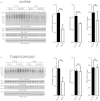O-linked β-N-acetylglucosamine modification of proteins is activated in post-ischemic brains of young but not aged mice: Implications for impaired functional recovery from ischemic stress
- PMID: 26661187
- PMCID: PMC4759674
- DOI: 10.1177/0271678X15608393
O-linked β-N-acetylglucosamine modification of proteins is activated in post-ischemic brains of young but not aged mice: Implications for impaired functional recovery from ischemic stress
Abstract
To evaluate the effect of age on the response of brains to an ischemic challenge, we subjected young and aged mice to transient forebrain ischemia, and analyzed the heat shock response and unfolded protein response, ubiquitin conjugation and SUMO conjugation, and O-linked β-N-acetylglucosamine modification of proteins (O-GlcNAcylation). The most prominent age-related difference was an inability of aged mice to activate O-GlcNAcylation. Considering many reports on the protective role of O-GlcNAcylation in various stress conditions including myocardial ischemia, this pathway could be a promising target for therapeutic intervention to improve functional recovery of aged patients following brain ischemia.
Keywords: Aging; O-GlcNAc modification; SUMO conjugation; brain ischemia; ubiquitin conjugation; unfolded protein response.
© The Author(s) 2015.
Figures


References
-
- Hallstrom B, Jonsson AC, Nerbrand C, et al. Stroke incidence and survival in the beginning of the 21st century in southern Sweden: comparisons with the late 20th century and projections into the future. Stroke 2008; 391: 10–15. - PubMed
-
- Kumar R, Krause GS, Yoshida H, et al. Dysfunction of the unfolded protein response during global brain ischemia and reperfusion. J Cereb Blood Flow Metabol 2003; 23: 462–71. - PubMed
Publication types
MeSH terms
Substances
Grants and funding
LinkOut - more resources
Full Text Sources
Medical

